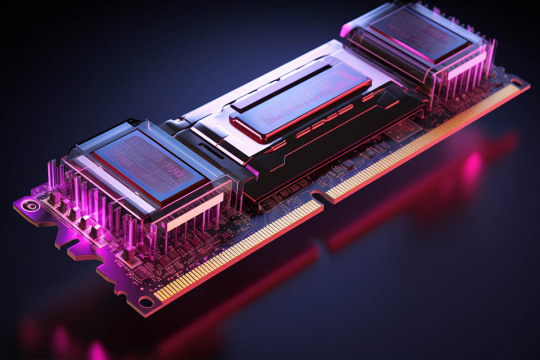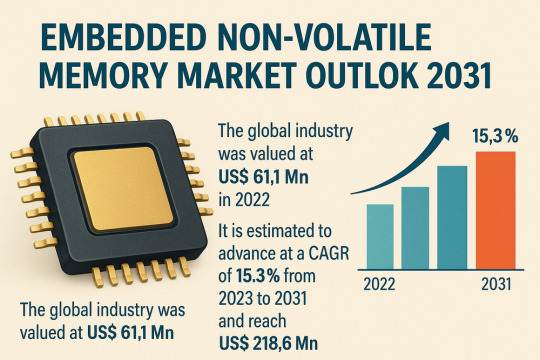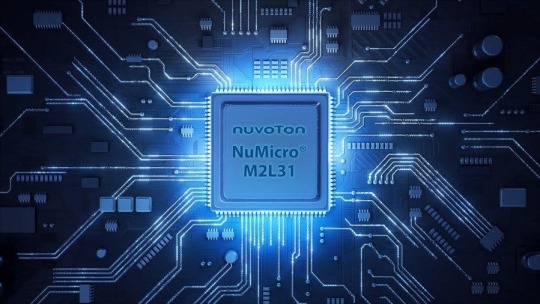#ReRAM
Explore tagged Tumblr posts
Link
🚀 The Future of Memory is Already Here From MRAM to ReRAM, FRAM to NRAM—a new wave of non-volatile memory is set to revolutionize how we store and access data. 🔋⚡
These advanced memory technologies deliver ultra-fast speed, endurance, and energy efficiency—making them essential for AI, IoT, mobile, and edge computing.
✨ Dive into the blog to explore: ✅ How each memory type works ✅ Why they're better than traditional DRAM/NAND ✅ Where the tech is heading next
💡 Perfect for tech lovers, hardware engineers, and future-focused minds.
#MRAM#ReRAM#FRAM#NRAM#TechInnovation#NonVolatileMemory#FutureOfStorage#PersistentMemory#EmergingTech#TumblrTech#MemoryRevolution
0 notes
Text
Hardware Implementation of Ring Oscillator
Excerpt from PDF: Hardware Implementation of Ring Oscillator Networks Coupled by BEOL Integrated ReRAM for Associative Memory Tasks Wooseok Choi1,+, Thomas van Bodegraven2,+, Jelle Verest2, Olivier Maher1, Donato F. Falcone1, Antonio La Porta1, Daniel Jubin1, Bert J. Offrein1, Siegfried Karg1, Valeria Bragaglia1,2*, Aida Todri-Sanial2*, 1IBM Research Europe, R¨uschlikon, Switzerland, 2Eindhoven…
1 note
·
View note
Photo

(via ReRAM la révolution du stockage, petit prix et force de frappe. - GoodNewsTech : Innovations, Bon plans, Tuto et Bonnes Nouvelles)
0 notes
Text
Last line tagged by @galacticlarry
For @1dastroficfest submission!
"“They’re called H-DRAM modules. High Density Random Access Memory modules. And probably some resistive RAMs. They might be called ReRAMs colloquially.”
Louis nodded, tapping that into his PULSE. “Doesn’t sound like the kind of thing Astra tends to get shipments of.”"
Tagging (but no pressure) @larry-hiatus, @enchantedlandcoffee, @babyhoneyheslt, @harruandlou
8 notes
·
View notes
Text
Emerging Applications of Next-Gen Memory in AI, IoT, and Edge Devices
Next-generation memory technologies are playing a transformative role in accelerating the capabilities of Artificial Intelligence (AI), the Internet of Things (IoT), and edge computing. As traditional memory solutions such as DRAM and NAND flash reach their physical and performance limits, next-gen memory types—like MRAM, ReRAM, FeRAM, and 3D XPoint—are stepping in to meet the growing demands for…
0 notes
Text
Embedded Non-volatile Memory Market to Hit $218.6 Million by 2031: What's Driving the Growth?

The global Embedded Non-volatile Memory (eNVM) market was valued at USD 61.1 million in 2022 and is projected to expand at a CAGR of 15.3% between 2023 and 2031, reaching USD 218.6 million by the end of 2031. Embedded NVM refers to non-volatile storage integrated directly into semiconductor chips, retaining data even when the system is powered off. Its core applications include firmware storage, calibration data retention, and secure configuration storage in microcontrollers, digital signal processors, and a wide array of embedded systems.
Market Drivers & Trends
Smartphone and Wearable Boom – The continued global uptake of mobile devices has escalated the need for larger, faster embedded memory. Users demand lightning-fast boot times and seamless multitasking, driving OEMs to integrate high-performance flash memory and emerging NVM technologies directly into system-on-chips (SoCs). – Wearables, smart speakers, and IoT gadgets prioritize low-density but highly efficient memory. 3D NAND flash has emerged as the preferred technology, offering high storage capacity in a minimal footprint. Samsung and SK Hynix have ramped up mass production of advanced 3D NAND modules tailored for connected device ecosystems.
Low-Power, High-Speed Requirements – Battery-powered devices mandate memory that combines rapid data access with minimal energy draw. Next-generation embedded NVMs—such as STT-MRAM and ReRAM—offer sub-microsecond access times and ultra-low standby currents, extending device lifespans and enhancing user experience. – System-in-Package (SiP) and Package-on-Package (PoP) solutions are gaining traction, integrating multiple memory dies and logic blocks into single compact modules, thereby reducing interconnect power losses and boosting overall throughput.
Security and Reliability – As embedded systems permeate mission-critical sectors (automotive ADAS, industrial controls, medical devices), secure and tamper-resistant memory is non-negotiable. Embedded flash and MRAM provide inherent read/write protections, while emerging PUF-based authentication schemes leverage intrinsic chip variability to safeguard cryptographic keys.
Latest Market Trends
3D XPoint and Beyond: Following its debut in enterprise SSDs, 3D XPoint is being miniaturized for embedded applications, promising DRAM-like speeds with non-volatility, ideal for real-time control systems.
Embedded MRAM/STT-MRAM: Gaining traction in safety-critical automotive and industrial sectors, MRAM offers unlimited endurance cycles and high radiation tolerance.
Embedded Ferroelectric RAM (FRAM): With nanosecond write speeds and high write endurance, FRAM is carving out niches in smart cards, metering, and medical devices.
Key Players and Industry Leaders The eNVM market is highly consolidated, with major semiconductor manufacturers and specialty memory providers driving innovation and capacity expansion:
eMemory Technology Inc.
Floadia Corporation
GlobalFoundries Inc.
Infineon Technologies AG
Japan Semiconductor Corporation
Kilopass Technology, Inc.
SK HYNIX INC.
SMIC
Texas Instruments Incorporated
Toshiba Electronic Devices & Storage Corporation
Download now to explore primary insights from our Report in this sample - https://www.transparencymarketresearch.com/sample/sample.php?flag=S&rep_id=24953
Recent Developments
March 2023 – ANAFLASH Commercialization U.S. startup ANAFLASH unveiled an energy-efficient embedded NVM solution tailored for battery-powered wireless sensors, medical wearables, and autonomous robots, promising up to 30% lower power consumption versus incumbent flash technologies.
February 2023 – GlobalFoundries Acquisition GlobalFoundries acquired Renesas Electronics’ resistive RAM patents and manufacturing know-how, aiming to integrate low-power ReRAM into next-generation SoCs for smart home and mobile applications.
May 2022 – Automotive Platform Collaboration Japan Semiconductor Corporation and Toshiba Electronic Devices partnered to develop a 0.13-micron analog IC platform with embedded flash, targeting advanced automotive applications such as in-vehicle networking and sensor fusion modules.
Market Opportunities
5G and IoT Rollout: The proliferation of 5G networks and edge computing devices demands local data storage and analytics, presenting growth avenues for low-latency embedded memory.
Automotive Electrification: Electric and autonomous vehicles require robust memory for ADAS, telematics, and battery management systems, creating new application segments.
Healthcare Wearables: Demand for continuous health monitoring fosters embedded memory integration in smart patches and implantable devices, where size and power constraints are paramount.
Future Outlook Analysts project that by 2031, the Embedded NVM market will surpass US$ 218 million, driven by sustained R&D investments and product diversification into emerging NVM technologies. The maturation of foundry support for STT-MRAM, ReRAM, and 3D XPoint, coupled with advanced packaging breakthroughs, will accelerate adoption across consumer, automotive, and industrial domains. Security-driven regulations and functional safety standards will further cement embedded memory’s role in next-generation electronic systems.
Market Segmentation
By Type
Flash Memory (dominant share in 2022)
EEPROM
nvSRAM
EPROM
3D NAND
MRAM/STT-MRAM
FRAM
Others (PCM, NRAM)
By End-Use Industry
Consumer Electronics (2022 market leader)
Automotive
IT & Telecommunication
Media & Entertainment
Aerospace & Defense
Others (Industrial, Healthcare)
By Region
North America
Europe
Asia Pacific (2022 market leader)
Middle East & Africa
South America
Buy this Premium Research Report for a detailed exploration of industry insights - https://www.transparencymarketresearch.com/checkout.php?rep_id=24953<ype=S
Regional Insights
Asia Pacific: Commanded the largest share in 2022, fueled by semiconductor R&D hubs in China, Japan, Taiwan, and South Korea, and robust electronics manufacturing ecosystems.
North America: Home to major foundries and design houses; 5G and IoT device adoption is expected to drive eNVM demand through 2031.
Europe: Automotive electrification and Industry 4.0 initiatives will underpin growth, with Germany and France leading demand.
MEA & Latin America: Emerging markets are gradually adopting consumer electronics and automotive technologies, presenting long-term opportunities.
Frequently Asked Questions
What is embedded non-volatile memory? Embedded NVM is memory integrated into semiconductor chips that retains data without power. It is used for firmware, configuration data, and security keys.
Which eNVM type holds the largest market share? Flash memory led the market in 2022 due to its balance of speed, density, and cost-effectiveness, particularly in consumer electronics and IoT devices.
What industries drive eNVM demand? Consumer electronics, automotive (ADAS, electrification), IT & telecom (5G equipment), aerospace & defense, healthcare wearables, and industrial automation.
How will emerging technologies impact the market? STT-MRAM, ReRAM, and 3D XPoint will offer faster speeds, higher endurance, and lower power profiles, expanding applications in safety-critical and high-performance systems.
Which regions offer the best growth prospects? Asia Pacific remains the leader due to manufacturing scale and R&D. North America and Europe follow, driven by advanced automotive and IoT deployments.
What factors may restrain market growth? High development costs for new NVM technologies, integration complexity, and supply chain disruptions in semiconductor fabrication could pose challenges.
Why is this report important for stakeholders? It equips semiconductor vendors, system integrators, and strategic investors with the insights needed to navigate technological shifts and seize emerging market opportunities in embedded memory.
Explore Latest Research Reports by Transparency Market Research:
Power Meter Market: https://www.transparencymarketresearch.com/power-meter-market.html
Radiation Hardened Electronics Market: https://www.transparencymarketresearch.com/radiation-hardened-electronics-semiconductor-market.html
AC-DC Power Supply Adapter Market: https://www.transparencymarketresearch.com/ac-dc-power-supply-adapter-market.html
5G PCB Market: https://www.transparencymarketresearch.com/5g-pcb-market.html
About Transparency Market Research Transparency Market Research, a global market research company registered at Wilmington, Delaware, United States, provides custom research and consulting services. Our exclusive blend of quantitative forecasting and trends analysis provides forward-looking insights for thousands of decision makers. Our experienced team of Analysts, Researchers, and Consultants use proprietary data sources and various tools & techniques to gather and analyses information. Our data repository is continuously updated and revised by a team of research experts, so that it always reflects the latest trends and information. With a broad research and analysis capability, Transparency Market Research employs rigorous primary and secondary research techniques in developing distinctive data sets and research material for business reports. Contact: Transparency Market Research Inc. CORPORATE HEADQUARTER DOWNTOWN, 1000 N. West Street, Suite 1200, Wilmington, Delaware 19801 USA Tel: +1-518-618-1030 USA - Canada Toll Free: 866-552-3453 Website: https://www.transparencymarketresearch.com Email: [email protected]
0 notes
Text
Next Generation Memory Market Resilience and Risk Factors Impacting Growth to 2033
The Next-Generation Memory (NGM) market is undergoing a transformative phase, driven by the escalating demands of artificial intelligence (AI), Internet of Things (IoT), and data-intensive applications. These advanced memory technologies, including Magnetoresistive RAM (MRAM), Resistive RAM (ReRAM), Phase-Change RAM (PCRAM), and High Bandwidth Memory (HBM), are poised to redefine data storage and processing paradigms.
Key Technologies and Applications
High Bandwidth Memory (HBM): Advanced memory solutions like HBM3E and HBM4 are being developed to meet the high-speed data processing requirements of AI and machine learning applications. For instance, Nvidia has requested SK Hynix to expedite the supply of HBM4 chips to support its AI technology development.
MRAM and ReRAM: These non-volatile memory technologies offer high endurance and low power consumption, making them ideal for IoT devices and embedded systems. Their integration into these devices ensures reliable data storage and fast access speeds.
PCRAM: Utilized in applications requiring high-speed data access and low latency, such as in-memory computing and real-time data processing systems.
Download a Free Sample Report: - https://tinyurl.com/yshzhzxy
Market Drivers
AI and Machine Learning: The surge in AI applications necessitates memory solutions that can handle vast amounts of data with minimal latency. Next-generation memory technologies are tailored to meet these demands, offering high-speed data access and processing capabilities.
IoT Expansion: The proliferation of IoT devices generates enormous data volumes, requiring efficient and reliable memory solutions. NGM technologies like MRAM and ReRAM provide the necessary speed and endurance to support the growing IoT ecosystem.
Data Center Evolution: Modern data centers require memory solutions that balance speed, capacity, and energy efficiency. NGM technologies are being integrated into data centers to enhance performance and reduce energy consumption.
Challenges and Considerations
High Manufacturing Costs: The production of next-generation memory technologies involves complex processes and specialized materials, leading to higher manufacturing costs compared to traditional memory solutions.
Integration Complexities: Integrating NGM technologies into existing systems and infrastructure can be challenging, requiring significant investment in research and development and potential redesigns of hardware components.
Future Outlook
The next-generation memory market is poised for substantial growth, driven by technological advancements and the increasing demands of AI, IoT, and data-intensive applications. As companies continue to innovate and develop more efficient and cost-effective memory solutions, the adoption of NGM technologies is expected to accelerate across various industries.
Recent Industry Developments
Nvidia's Request to SK Hynix: Nvidia has asked SK Hynix to expedite the delivery of HBM4 chips by six months to support its AI technology development, highlighting the growing need for advanced memory solutions in AI applications.
Micron's Expansion Plans: Micron Technology is expanding its market share in high-bandwidth memory chips, with new R&D facilities in the U.S. and potential production in Malaysia, aiming to meet the increasing demand for advanced memory solutions.
Read Full Report: - https://www.uniprismmarketresearch.com/verticals/semiconductor-electronics/next-generation-memory
0 notes
Text
In-Memory Computing Chips: The Next Big Thing? Market to Hit $12.4B by 2034
In-Memory Computing Chips Market is experiencing rapid growth as industries demand faster data processing, real-time analytics, and energy-efficient computing. Unlike traditional architectures, in-memory computing chips store and process data in the same location, eliminating latency and dramatically improving performance. This breakthrough technology is transforming industries such as AI, big data, edge computing, healthcare, finance, and autonomous systems.
To Request Sample Report: https://www.globalinsightservices.com/request-sample/?id=GIS10637 &utm_source=SnehaPatil&utm_medium=Article
Why In-Memory Computing Chips?
✅ Accelerate AI & machine learning applications ✅ Enable real-time big data analytics ✅ Reduce power consumption & latency ✅ Optimize cloud computing & edge AI
Market Growth Drivers:
📈 Growing demand for AI-driven computing & deep learning 📈 Expansion of IoT, 5G, and high-performance computing (HPC) 📈 Rising need for energy-efficient data centers & cloud infrastructure 📈 Advancements in neuromorphic and resistive RAM (ReRAM) technologies
The global in-memory computing chips market is set to expand, with major tech giants and startups investing in AI accelerators, neuromorphic computing, and next-gen memory architectures. As AI, blockchain, and real-time analytics continue to evolve, in-memory computing is emerging as a critical enabler of high-speed, low-latency processing.
With quantum computing and edge AI pushing the limits of traditional computing, in-memory computing chips are paving the way for a faster, smarter, and more efficient digital future.
What are your thoughts on in-memory computing? Let’s discuss! 👇
#InMemoryComputing #AIAccelerators #EdgeAI #HighPerformanceComputing #BigData #RealTimeAnalytics #CloudComputing #MachineLearning #ArtificialIntelligence #NeuromorphicComputing #NextGenChips #TechInnovation #AIChips #DataProcessing #DeepLearning #IoT #5G #QuantumComputing #SmartComputing #ChipTechnology #EnergyEfficientTech #HPC #DataCenters #ReRAM #CloudAI #AIHardware #FutureOfComputing #FastProcessing #LowLatency #NextGenMemory 🚀
Research Scope:
· Estimates and forecast the overall market size for the total market, across type, application, and region
· Detailed information and key takeaways on qualitative and quantitative trends, dynamics, business framework, competitive landscape, and company profiling
· Identify factors influencing market growth and challenges, opportunities, drivers, and restraints
· Identify factors that could limit company participation in identified international markets to help properly calibrate market share expectations and growth rates
· Trace and evaluate key development strategies like acquisitions, product launches, mergers, collaborations, business expansions, agreements, partnerships, and R&D activities
About Us:
Global Insight Services (GIS) is a leading multi-industry market research firm headquartered in Delaware, US. We are committed to providing our clients with highest quality data, analysis, and tools to meet all their market research needs. With GIS, you can be assured of the quality of the deliverables, robust & transparent research methodology, and superior service.
Contact Us:
Global Insight Services LLC 16192, Coastal Highway, Lewes DE 19958 E-mail: [email protected] Phone: +1–833–761–1700 Website: https://www.globalinsightservices.com/
0 notes
Text
Next-Generation Memory Market Revenue, Statistics, and Business Strategy Until 2032
Next-generation memory technologies are set to transform data storage and processing, offering faster speeds, higher capacities, and lower power consumption than traditional memory solutions. These advanced memory types, including Resistive RAM (ReRAM), Magnetoresistive RAM (MRAM), Phase-Change Memory (PCM), and 3D XPoint, are designed to meet the growing demands of modern applications such as artificial intelligence, big data analytics, cloud computing, and autonomous systems. With the limitations of traditional DRAM and NAND flash memory becoming more evident, next-generation memory solutions provide a path forward for industries that require faster, more efficient data handling and retrieval.
The Next-Generation Memory Market size was valued at USD 6.3 billion in 2022 and is expected to grow to USD 33.65 billion by 2030 and grow at a CAGR of 23.3% over the forecast period of 2023-2030.
Future Scope
The future of next-generation memory lies in its ability to address the needs of data-intensive applications. As AI, machine learning, and autonomous systems evolve, there will be an increasing demand for memory that can process large datasets with minimal latency. Next-generation memory solutions will enable faster training of AI models and real-time data processing, making them essential for technologies like self-driving cars, smart cities, and high-frequency trading systems. Additionally, as data centers become more power-conscious, the adoption of energy-efficient memory technologies will grow, reducing the environmental impact of large-scale data storage.
Trends
Key trends in next-generation memory include the move towards non-volatile memory (NVM) technologies, which retain data even when power is turned off, making them ideal for applications requiring persistent storage. Another trend is the development of memory technologies that can combine the speed of DRAM with the non-volatility of traditional storage. The rise of 3D memory architectures, where memory cells are stacked vertically, is also revolutionizing the industry by enabling higher storage densities. Furthermore, the increasing demand for memory solutions optimized for AI and machine learning workloads is driving innovation in next-generation memory technologies.
Applications
Next-generation memory technologies are being deployed across various industries, particularly in areas that require high-speed data processing and storage. In AI and machine learning, these memory solutions enable faster model training and real-time inference, improving overall system performance. Data centers are adopting next-generation memory to enhance data retrieval speeds while reducing energy consumption. In the automotive industry, next-generation memory is crucial for autonomous driving systems, where rapid data processing is needed for real-time decision-making. Consumer electronics, such as smartphones and laptops, also benefit from next-generation memory, with faster boot times and enhanced application performance.
Solutions and Services
Next-generation memory providers offer solutions that cater to the unique needs of high-performance computing and data storage applications. These solutions include high-speed memory modules, non-volatile storage options, and hybrid memory architectures that combine the best attributes of DRAM and flash storage. Service providers offer integration services, helping industries adopt next-generation memory into their existing infrastructure. Additionally, companies are developing software tools to optimize memory usage for AI and data analytics workloads, ensuring seamless integration and maximum performance from these cutting-edge memory technologies.
Key Points
Next-generation memory offers faster speeds, higher capacities, and lower power consumption.
Emerging memory technologies include ReRAM, MRAM, PCM, and 3D XPoint.
Non-volatile memory and 3D architectures are key trends shaping the future of memory.
Applications range from AI and machine learning to data centers and autonomous vehicles.
Solutions include high-speed modules, hybrid architectures, and memory optimization services.
Read More Details: https://www.snsinsider.com/reports/next-generation-memory-market-4086
Contact Us:
Akash Anand — Head of Business Development & Strategy
Email: [email protected]
Phone: +1–415–230–0044 (US) | +91–7798602273 (IND)
0 notes
Text
0 notes
Text
RRAM or ReRAM (resistive random access memory)
http://i.securitythinkingcap.com/T9QdMs
0 notes
Text
0 notes
Photo

Nuvoton Unveils Its ReRAM-Packing Low-Power Arm Cortex-M23-Based M2L31 Microcontroller Range
0 notes
Text
Innovations in Next-Generation Memory: From MRAM to ReRAM and Beyond
With the explosion of artificial intelligence (AI), cloud computing, 5G, and the Internet of Things (IoT), the demand for faster, more efficient, and highly durable memory solutions has skyrocketed. Traditional memory technologies like DRAM and NAND flash are reaching their limits in terms of speed, endurance, and power efficiency. This has led to the rise of next-generation memory technologies,…
0 notes
Text
Next-Generation Memory Market by Technology (Non-Volatile Memory (MRAM (STT-MRAM, SOT-MRAM, Toggle Mode MRAM), FRAM, RERAM/CBRAM, 3D XPoint, NRAM), and Volatile Memory (HBM, and HMC)), Wafer Size (200 mm, and 300 mm)
0 notes
Text
Ram lalla padhare Aapne Dham
Ram lalla viraje reRam lalla padhare Aapne Dham

View On WordPress
0 notes